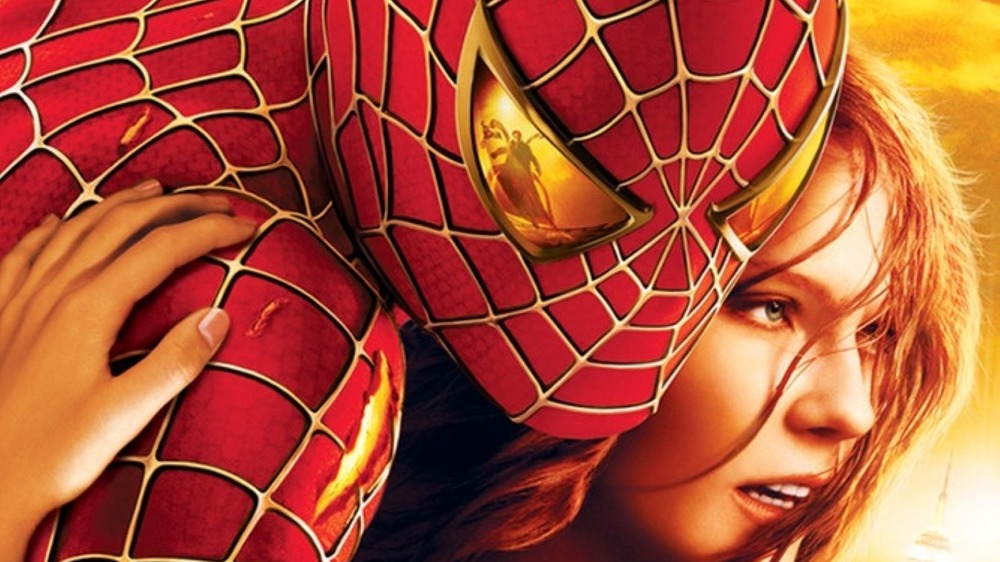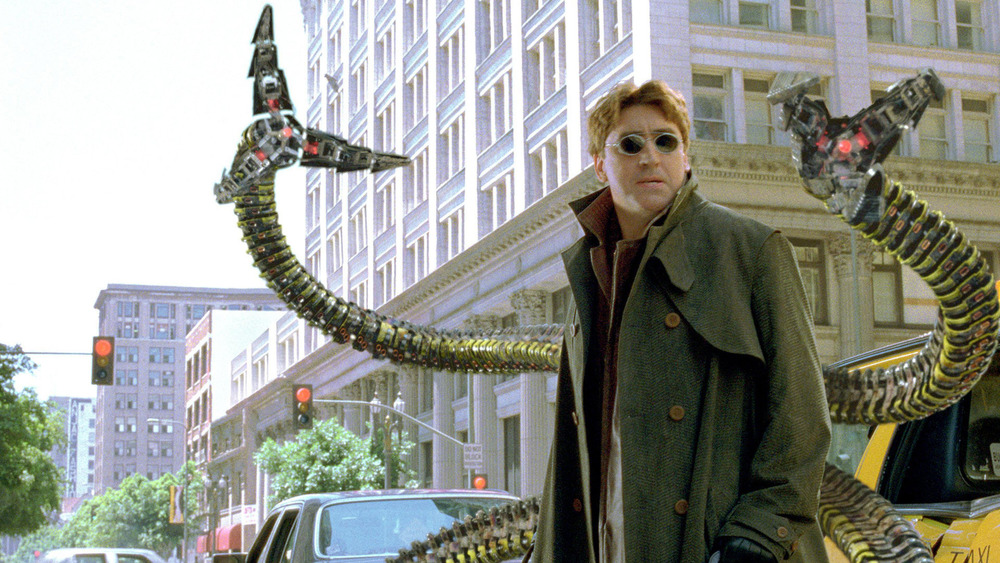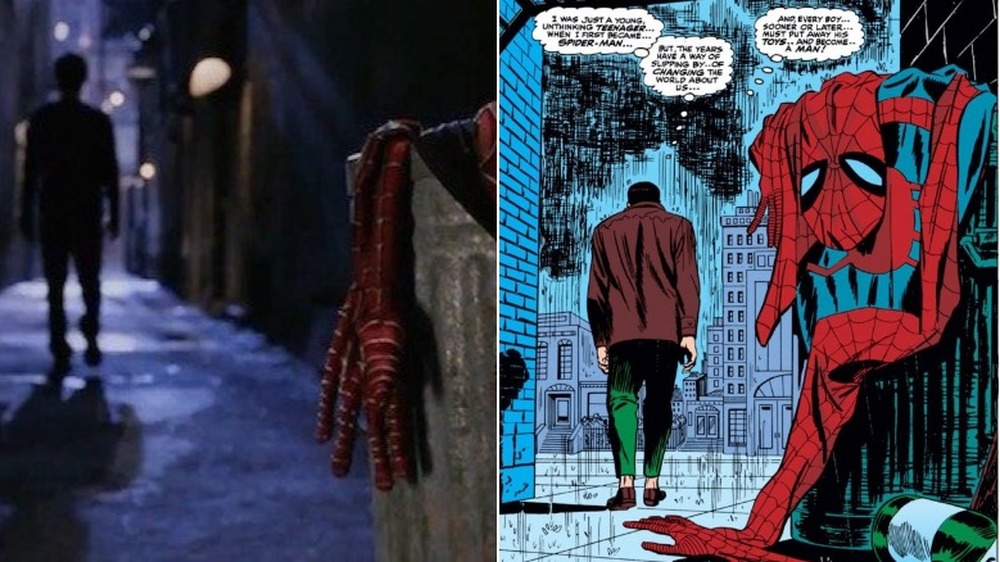Why Spider-Man 2 Is The Best Of Sam Raimi's Spider-Man Trilogy
As the flagship character of Marvel Comics, it's no wonder there are so many Spider-Man movies (even if the constant reboots can get kind of annoying). As the late, great Stan Lee intended, from when he first created the character back in the early 1960s, the films emphasize not only Spidey's superhero life, but his civilian identity as Peter Parker. Other Marvel heroes may be super-soldiers or billionaires or gods, but Peter? Aside from being a gifted scientist, he's a pretty normal guy, thrust into extraordinary situations. Other superheroes have since caught onto the trend (including on the DC side of the fence), but the wallcrawler was among the first — and best — to do it.
Sam Raimi wholly embraced this concept for his Spider-Man trilogy, starring a then-relatively unknown actor named Tobey Maguire as the titular webslinger. As such, his films downplay some of the more fantastical elements of the comics — clones, killer robots, and even Peter's scientific mind to an extent — in favor of very human stories. That's not to say the films aren't comic book movies, though, because they absolutely are: The superpowered brawls and dashes of melodrama are still there.
Of all three films, though, Spider-Man 2 definitely has the most going for it. Spider-Man kicked things off more than adequately, establishing the characters and tone of the trilogy well, but it does struggle to find its footing at times. Spider-Man 3 struggles to find its footing pretty much for the duration of the film, making for what's generally considered an unsatisfying conclusion.
What is it, exactly, that places the middle child of Raimi's trilogy at the top? Let's discuss.
A villainous performance for the ages
After pitting Spidey against the Green Goblin (Willem Dafoe), one of his most legendary foes, there were a lot of directions Raimi could've gone, as the hero has amassed quite a rogues gallery over the years. Raimi wisely decided on Doctor Octopus, a dangerous and brilliant scientist who's been a thorn in the web-head's side since his earliest days. Though the Doc Ock of the movie isn't exactly the Doc Ock of the comics, Alfred Molina's performance, and the writing behind it, are masterful.
Like Ian McKellen's Magneto before him, Molina's Doc Ock is more than just a force to be reckoned with: he's also a fully-formed, sympathetic character. Before making him a supervillain, the film shows him as Dr. Otto Octavius — a man trying to change the world, a loving husband, and a brilliant mentor to Peter. They don't have much time together before things go awry, but the scientific and personal sparks between them transcend the screen, tinging their eventual mutual animosity with a deep sadness. Indeed, even after Otto's neural chip fries and he loses control to his four-armed harness, the man Peter once knew is still in there, somewhere.
That man comes out once again in their final confrontation, after Peter knocks some sense into the good doctor and removes his mask. Unsure how to stop the fusion reactor Otto built, Peter appeals to the man's goodwill, as both a scientist and a human being. It works, and Otto agrees to destroy the reactor ... however, the captain must go down with the ship. After watching him change from a decent man to a deadly villain and back again, there are a lot of emotions stirring as he sinks to the bottom of the river, eyes vacant.
Molina was deservedly nominated for a number of awards for the role, leaving behind a legacy for all supervillain actors to live up to.
Can't top the train tussle
Of every live-action Spider-Man action scene ever filmed — including those outside the Raimi trilogy — the train scene remains the best.
To be fair, there are definitely a few criticisms that can be leveled against it, such as how the non-superpowered Ock takes such a walloping, or how Maguire's Spidey doesn't make any of the character's trademark quips throughout. Other than those gripes, though, the scene — bolstered by Danny Elfman's hummable score — is a masterpiece that, alone, elevates the movie to new heights. Mary Jane (Kirsten Dunst) has been captured, so Spidey has every reason to go at Doc Ock with everything he's got, and that's exactly what he does. From start to finish, the melee almost never lets up, more of a no-holds-barred brawl than one of the many send-your-opponent-flying bouts so common in superhero movies. There's a true weight behind every punch, every tentacle slam, every collision with the train or its surroundings. Describing it doesn't give the scene the justice it deserves.
Frustrated with how the fight's going, Doc Ock decides to ramp things up a notch by breaking the control panel. "You have a train to catch," he says to Spidey, leaving the hero with the lives of countless civilians in his hands. Peter does everything he can to save them, even if it means shedding his mask to see more clearly and exposing his identity. Channeling every last ounce of his super-strength, he webs the buildings beside the tracks and braces himself. It works, but he faints from the exertion.
The people on the train lay him down while he recovers, remarking that beneath the mask, he's just... a guy. A regular person, like any of them. It's a genuine way of conveying that Spidey's a hero of the people, in the truest sense of the phrase. What better way to honor the hero's decades-long legacy, than having New Yorkers themselves thank him? Those emotions go beyond mere words.
Spider-Man vs. Peter Parker
In 1967, Marvel published what is, to this day, one of Spider-Man's most famous arcs: "Spider-Man No More!" by Stan Lee and John Romita Sr., a story best summed up by Peter himself: "So long as I hang on to my Spider-Man identity I haven't time for anything — except new problems!"
Taking care of Aunt May, balancing his love life, staying on top of his classes... it all seems impossible, while simultaneously swinging around the city stopping crime. This is the main drama of Spider-Man 2, as well: How can Peter be a hero and live the life he wants to live? There's no easy answer. He either has to make a choice, or let his problems continue to mount. In the movie, the emotional stress causes his powers to fluctuate at the worst possible times, so the choice seems clear — abandon Spider-Man, embrace Peter Parker. At first, it feels like the right thing to do. Peter's life starts turning around for the better in pretty much every possible way, humorously emphasized by a montage set to the song "Raindrops Keep Fallin' On My Head" by B. J. Thomas. Unfortunately for him, the rise of Doc Ock — and the capture of Mary Jane — forces him to get his Spider-Man identity back in the game, powers fully restored. But really, who in their right mind would let their significant other get kidnapped and not want to do anything about it?
Compared to the main drama of its companion films, this inner struggle not only feels the most natural, but the most authentically Spider-Man. The first movie is about learning the ropes and contending with the personal and relationship-related risks that come with being a hero, and it's effective enough. The third movie explores Peter's dark side, if somewhat inorganically. Spider-Man 2's conflict, though, has a greater sense of urgency than either, as well as more tangible and emotionally-charged consequences.
For all these reasons, it's the best of the Raimi trilogy. Now, how does it stack up against the rest of Spider-Man's big screen outings? Or against superhero movies in general? Well, that depends on who you ask, but it's pretty darn good, regardless.



